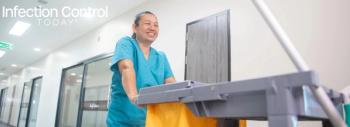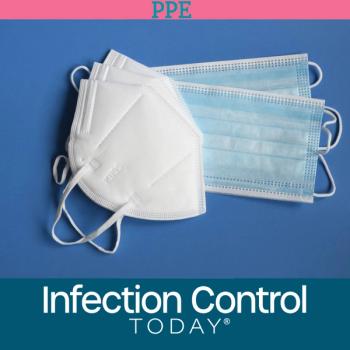
- Infection Control Today, January/February 2025 (Vol. 29 No.1)
- Volume 29
- Issue 1
A Day in the Life of a Pathogen: From Your Hands to Stethoscopes and Beyond
A silent invader lurks in health care settings, exploiting human oversights to spread. Discover how vigilance, hand hygiene, and disinfection can stop infections before they begin.
The morning light filters into the surgical intensive care unit, washing over the beeping monitors and scurrying footsteps of the nurses making their rounds. Cups of coffee litter the nursing station, the sunlight catching the steam like waves floating through the air. For most, it’s just another day filled with managing drips, dressing wounds, and comforting loved ones. But for me, it’s an opportunity.
You can’t see me, but I’m here. I thrive amid unclean hands, dirty stethoscopes, and portable ultrasound machines. I lie in the quiet corners that have long been forgotten. And although you may know me as methicillin-resistant Staphylococcus aureus bacteria, you underestimate how proficient I am at silently spreading through your quarters. You underestimate us all. To you, I’m just a pathogen that occasionally causes skin infections, pneumonia, or sepsis, to name a few. But I’m an explorer, a conqueror, a survivor of health care worlds. And you remain blissfully unaware of the part you play in my story. My mission is simple: Spread, colonize, thrive, and repeat.
Today, I’m beginning my morning in the darkness, hiding within the folds of a health care worker’s scrubs who’s hastily stashed contaminated medical supplies in her pockets. It’s a cozy haven I’ve nestled in during her preparation for today’s shift. The air smells faintly of disinfectant, but I know better than to fear it. Human carelessness is my ally, and I sense that my next move is close at hand.
First Contact
A nurse enters room 302, her gloved hands expertly adjusting an intravenous (IV) line. A patient, post-op, total knee, is lulled to sleep by the last remnants of anesthesia. The nurse finishes her task and quickly moves to her next patient without a second thought.
As she removes her gloves, she reaches into her pocket for supplies where I lie waiting. Ah, a familiar sight: As I now cling to the webbing between her fingers, she absentmindedly passes by the hand sanitizer and enters her next room. And in a moment of minor oversight or a mere split second of distraction, my prime opportunity appears.
A Grave Error
In room 305, my new host is waiting—a patient recovering from abdominal surgery. His immune defenses are already weak, and a dressing change provides a golden opportunity for me to strike.
The nurse reaches for her stethoscope draped lightly around her neck, touching her contaminated hands to the diaphragm. Stethoscopes are my favorite highway to infection. They’re carried everywhere by these medical teams, pressed against patient after patient, picking up bacterial hosts along the way. Their owners rarely stop to disinfect them during the rush of a busy day, giving my friends and me an easy mode of transmission. As she moves the stethoscope along the patient’s body, I quietly await the perfect moment of attack. She listens to his beating heart and the breath in his lungs before pausing at his abdomen to listen closely for a rumbling within. At that moment, I make my move, sliding effortlessly away from the stethoscope and onto my new host’s skin.
The incision lies only inches away from where I’ve landed. My multiplication under the dressing alone would suffice. As the nurse transitions to the dressing change, she begins meticulously opening the supplies for the procedure. Although she’s careful not to contaminate the dressing materials inside, she will soon make another grave error, which will cause the patient a deadly infection. “Ring, ring, ring, ring,” the familiar tone of the nurse’s phone chimes within her pocket. As she reaches inside to grab it, I cling to the phone as it’s removed. She listens for a minute to the charge nurse on the other end, receiving instructions for her next patient. The conversation is long enough for me to also advance from the phone to her hands, another opportunity to invade my new host.
The Microbial Invasion
The nurse doesn’t bother using hand sanitizer after touching her phone. She doesn’t recognize the possibility that she’s contaminated her hands by the activity. So, she returns to the task in front of her as I find my way to the clean dressing supplies on the bedside table. This is where I’ll shine, infiltrating and multiplying in the most vulnerable and vital parts of my new host’s body.
My job is done by the time the nurse has donned her sterile gloves. Now, all I need to do is wait for the supposedly clean supplies to be placed atop the patient’s surgical wound. From there, I stealthily detach myself from the mesh dressing and find my way between the staples of my host’s fresh surgical wound.
As the sun rises higher, the patient stirs as I enter his bloodstream. The fever will come soon, followed by a rapid heartbeat and a drop in blood pressure. I thrive in this chaos, feeding on the body’s attempt to fight back as I quickly multiply, untouched by the antibiotics the medical team will first attempt. My multiplication is swift and efficient. Within hours, I’ve set up colonies in the patient’s body, disrupting his delicate internal stability. The immune system responds swiftly, but his defenses are a weak attempt to win my war.
Nurses rush to stabilize my host, unaware that I’m the culprit. Blood cultures, IV fluids, surgical washout, and yes, even their hands—all offer new pathways for me to spread. This is how I will win: one small oversight at a time, one unclean stethoscope or phone at a time, carried by the hands of a blissfully unaware health care worker.
The Interruption
Alas, every so often, vigilance will come along. When I’m sure I’ve won, a new nurse enters the room. Her first move? Sanitizing her hands with deliberate care. She reaches for the stethoscope and pauses, grabbing one of the disinfectant wipes from the canister on the wall.
“No. Not this. Please, not this,” I think.
The wipe’s sting is immediate, its alcohol content deadly. I cling desperately to the stethoscope’s surface, but it’s useless. With each pass of the wipe, my numbers quickly dwindle. The nurse cleans the diaphragm, the tubing, and even the earpieces—a comprehensive job.
She’s one of the vigilant ones, the kind I hate. The sort who knows the importance of disinfecting even the smallest of medical tools. As she moves to the patient, her hands freshly sanitized and her stethoscope disinfected, I find myself finally defeated. My plans for continued transmission are completely foiled.
Reflections and Warnings
This wasn’t my first defeat, nor will it be my last. Humans like to think they’re winning this war against our microbial army, but I know better. Complacency will always be our greatest ally. Ignorance will help us win this war.
Every skipped hand wash, every unclean stethoscope, and every rushed moment will always create another opportunity for me. I need only 1 oversight, 1 breach in your routine, to make my final move.
But here’s the thing: Although I may be resilient, I’m not invincible. Alcohol wipes, proper hand hygiene, and consistent cleaning practices are my kryptonite. These small acts disrupt my plans and stop me from spreading throughout your facilities.
Knowledge and vigilance are your greatest weapons. Treat every stethoscope like a critical tool and disinfect it regularly. Wash your hands like lives depend on it—because they do.
I’ll be waiting in the morning light for your next mistake. The question is: Will you let me win?
A Call to Action
Health care is a battlefield, and the fight against this invisible microbial army is ongoing. The stakes are high, but the tools to win are simple: hand hygiene, cleaning, disinfection, sterilization, proper use of personal protective equipment, and aseptic technique. These and other prevention measures can and will save lives—if you choose to believe in the power of these interventions. Let this story be a reminder that every scrub, every wipe, every moment of vigilance in infection prevention and control matters. Together, we can ensure that a pathogen’s story ends at the next disinfectant wipe or hand sanitizer dispenser.
Articles in this issue
Newsletter
Stay prepared and protected with Infection Control Today's newsletter, delivering essential updates, best practices, and expert insights for infection preventionists.






